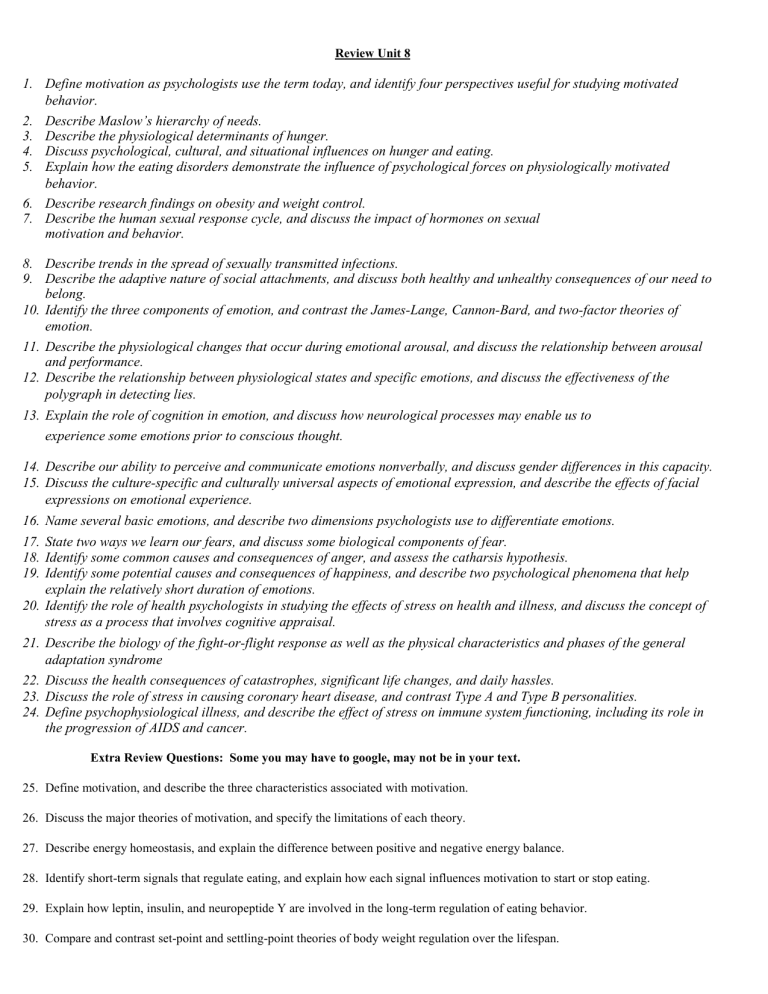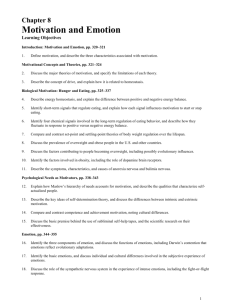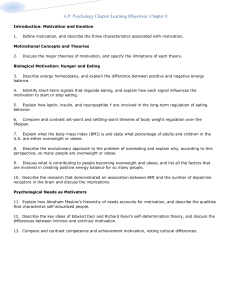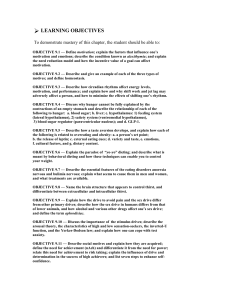Review Unit 8 Define motivation as psychologists use the term today

Review Unit 8
1.
Define motivation as psychologists use the term today, and identify four perspectives useful for studying motivated behavior.
2.
Describe Maslow’s hierarchy of needs.
3.
Describe the physiological determinants of hunger.
4.
Discuss psychological, cultural, and situational influences on hunger and eating.
5.
Explain how the eating disorders demonstrate the influence of psychological forces on physiologically motivated behavior.
6.
Describe research findings on obesity and weight control.
7.
Describe the human sexual response cycle, and discuss the impact of hormones on sexual motivation and behavior.
8.
Describe trends in the spread of sexually transmitted infections.
9.
Describe the adaptive nature of social attachments, and discuss both healthy and unhealthy consequences of our need to belong.
10.
Identify the three components of emotion, and contrast the James-Lange, Cannon-Bard, and two-factor theories of emotion.
11.
Describe the physiological changes that occur during emotional arousal, and discuss the relationship between arousal and performance.
12.
Describe the relationship between physiological states and specific emotions, and discuss the effectiveness of the polygraph in detecting lies.
13.
Explain the role of cognition in emotion, and discuss how neurological processes may enable us to experience some emotions prior to conscious thought.
14.
Describe our ability to perceive and communicate emotions nonverbally, and discuss gender differences in this capacity.
15.
Discuss the culture-specific and culturally universal aspects of emotional expression, and describe the effects of facial expressions on emotional experience.
16.
Name several basic emotions, and describe two dimensions psychologists use to differentiate emotions.
17.
State two ways we learn our fears, and discuss some biological components of fear.
18.
Identify some common causes and consequences of anger, and assess the catharsis hypothesis.
19.
Identify some potential causes and consequences of happiness, and describe two psychological phenomena that help explain the relatively short duration of emotions.
20.
Identify the role of health psychologists in studying the effects of stress on health and illness, and discuss the concept of stress as a process that involves cognitive appraisal.
21.
Describe the biology of the fight-or-flight response as well as the physical characteristics and phases of the general adaptation syndrome
22.
Discuss the health consequences of catastrophes, significant life changes, and daily hassles.
23.
Discuss the role of stress in causing coronary heart disease, and contrast Type A and Type B personalities.
24.
Define psychophysiological illness, and describe the effect of stress on immune system functioning, including its role in the progression of AIDS and cancer.
Extra Review Questions: Some you may have to google, may not be in your text.
25.
Define motivation, and describe the three characteristics associated with motivation.
26. Discuss the major theories of motivation, and specify the limitations of each theory.
27. Describe energy homeostasis, and explain the difference between positive and negative energy balance.
28. Identify short-term signals that regulate eating, and explain how each signal influences motivation to start or stop eating.
29. Explain how leptin, insulin, and neuropeptide Y are involved in the long-term regulation of eating behavior.
30. Compare and contrast set-point and settling-point theories of body weight regulation over the lifespan.
31. Discuss the prevalence of overweight and obese people in the United States and other countries.
32. Discuss the factors contributing to people becoming overweight or obese, including possible evolutionary influences and reduced dopamine receptors in the brain.
33. Describe the symptoms, characteristics, and causes of anorexia nervosa and bulimia nervosa.
34. Explain how Maslow’s hierarchy of needs accounts for motivation, and describe the qualities that characterize self-actualized people.
35. Describe the key ideas of Deci and Ryan’s self-determination theory, and discuss the differences between intrinsic and extrinsic motivation.
36. Compare and contrast competence and achievement motivation, noting cultural differences.
37. Summarize the research findings on the effectiveness of subliminal self-help tapes.
38. Identify the three components of emotion, and discuss the functions of emotions, including Darwin’s contention that emotions reflect evolutionary adaptations.
39. Identify the basic emotions, and discuss individual and cultural differences involved in the subjective experience of emotions.
40. Discuss the role of the sympathetic nervous system in the experience of intense emotions, including the fight-or-flight response.
41. Describe the two brain pathways involved in triggering fear, how they differ, and their evolutionary significance.
42. Discuss the polygraph, microexpressions, and brain fingerprinting as techniques to detect lies.
43. Discuss the idea that facial expressions of basic emotions are innate, and explain how facial expressions are affected by cultural display rules.
44. Define anthropomorphism, and discuss the idea that nonhuman animals experience emotion.
45. Compare and contrast the major theories of emotion, and explain the facial feedback hypothesis.
46. Define self-efficacy, and identify different ways to strengthen your sense of self-efficacy.
47. Discuss how to create and use implementation intentions to help achieve your goals.








